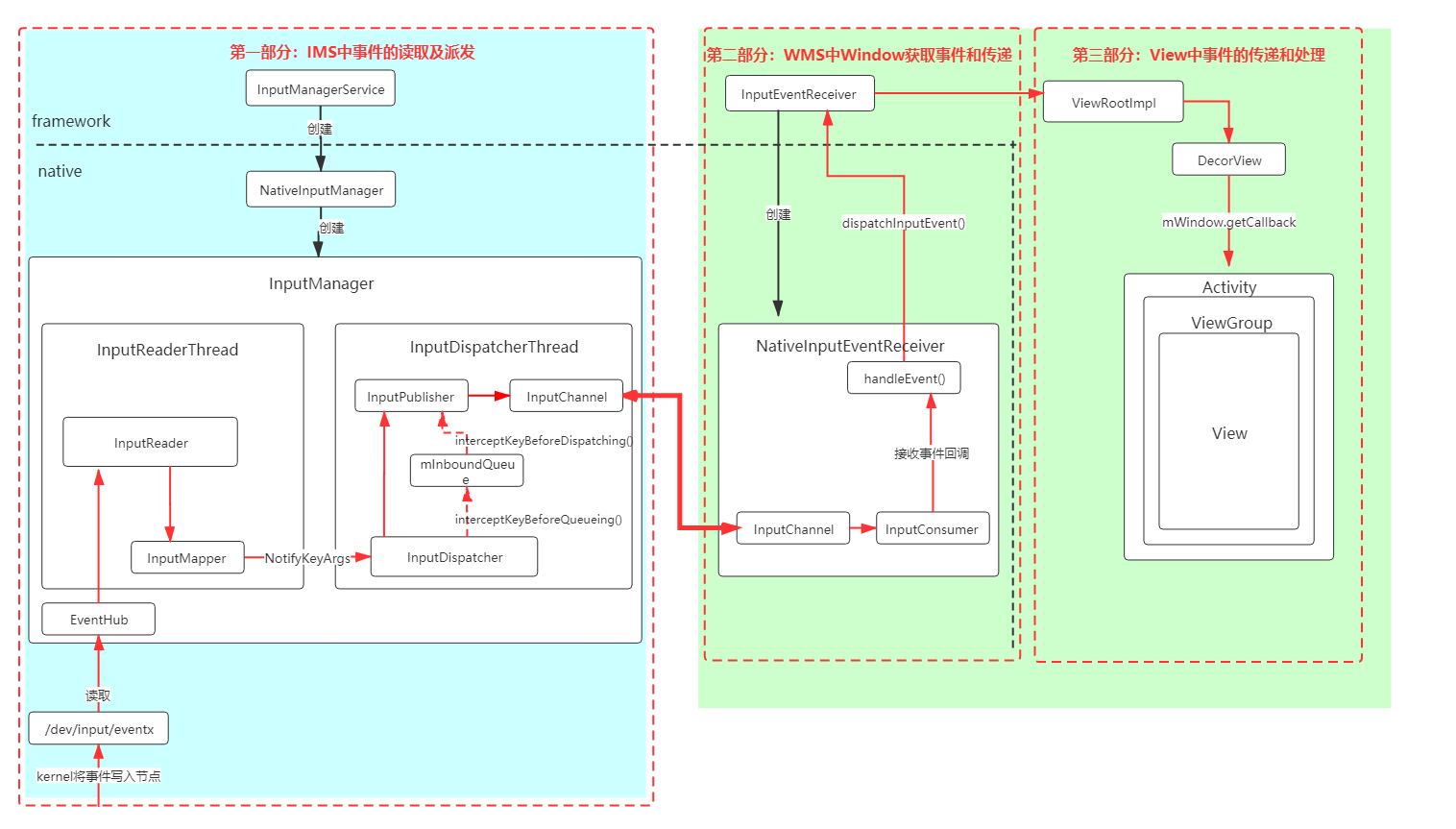前言和概述
Android的输入设备,最常用的就是 触摸屏和按键 了。当然还有其他方式,比如游戏手柄,比如支持OTG设备,则可以链接鼠标、键盘等。
那么这些设备的操作 是如何传递到系统 并 控制界面的呢?系统如何知道是如何知道点击了某个界面按钮,按了某个按键,知道交给哪个应用处理的?
该篇主要介绍这些,即 输入事件从生成(存于设备节点中) 传递到目标View的过程。 在进入输入事件传递机制之前,首先了解一个东西---设备节点。
了解设备节点
当有输入事件时,Linux内核会将事件数据写入 设备节点 中,供上层读取最终传递到具体的View中。 该备节点 位于/dev/input/。
1. 查看:输入事件相关设备信息
与事件相关的设备信息位于:/proc/bus/input/devices。
下面是一部分,大致了解下。Name对应的Handlers注意下。
//查看所有事件相关设备信息$ adb shell cat /proc/bus/input/devices I: Bus=0019 Vendor=0000 Product=0000 Version=0000 N: Name="ACCDET" P: Phys= S: Sysfs=/devices/virtual/input/input0 U: Uniq= H: Handlers=event0 B: PROP=0 B: EV=23 B: KEY=40 0 0 0 0 0 0 0 0 0 0 0 0 10 0 c0000 0 0 0 B: SW=d4 I: Bus=0019 Vendor=2454 Product=6500 Version=0010 N: Name="mtk-kpd" P: Phys= S: Sysfs=/devices/platform/10010000.kp/input/input1 U: Uniq= H: Handlers=event1 B: PROP=0 B: EV=3 B: KEY=1000000 0 0 0 0 0 0 0 0 1c0000 0 0 0 ...
2. 命令:getevent 和 sendenvent
2.1 getevent
通过设备的getevent命令,可以查看输入事件的信息。
//获取输入事件,这里是按了下电源键$ adb shell getevent add device 1: /dev/input/event0 name: "ACCDET" add device 2: /dev/input/event2 name: "sf-keys" add device 3: /dev/input/event3 name: "mtk-tpd" add device 4: /dev/input/event1 name: "mtk-kpd" /dev/input/event1: 0001 0074 00000001 /dev/input/event1: 0000 0000 00000000 /dev/input/event1: 0001 0074 00000000 /dev/input/event1: 0000 0000 00000000//从/proc/bus/input/devices获取到要关注的设备的节点,可以单独获取//下面是获取也是按的电源键获取到的$ adb shell getevent /dev/input/event1 0001 0074 00000001 0000 0000 00000000 0001 0074 00000000 0000 0000 00000000//多了解参数,这个-l就很清楚了//-l: label event types and names in plain text$ adb shell getevent -l /dev/input/event1 EV_KEY KEY_POWER DOWN EV_SYN SYN_REPORT 00000000 EV_KEY KEY_POWER UP EV_SYN SYN_REPORT 00000000
上面列出的3种,第一种没有参数 获取所有输入事件。加上 -l参数 的结果就很清晰了。
事件类型: 0001 即 EV_KEY,按键
事件代码: 0074 即 KEY_POWER,电源键
事件的值: 00000001 即 DOWN,按下;00000000 即 UP,抬起。
/dev/input/event1: 0001 0074 00000001 就是 电源键按下了。
/dev/input/event1: 0001 0074 00000000 就是 电源键抬起了。
注意:这里的值 都是 16进制的。
触摸屏幕也一样:
//触摸屏幕截取/dev/input/event3: EV_ABS ABS_MT_TOUCH_MAJOR 0000001e /dev/input/event3: EV_ABS ABS_MT_TRACKING_ID 00000000 /dev/input/event3: EV_ABS ABS_MT_POSITION_X 000001b5 /dev/input/event3: EV_ABS ABS_MT_POSITION_Y 000001e1 /dev/input/event3: EV_SYN SYN_MT_REPORT 00000000 /dev/input/event3: EV_SYN SYN_REPORT 00000000
2.2 sendenvent
输入事件 设备节点也是可写的,通过sendevent可模拟用户输入。
但 sendevent 的参数是 十进制。
格式:sendevent <设备节点> <事件类型> <事件代码> <事件的值>
所以getevent中,电源按下/抬起的:事件类型即1,事件代码即116,事件的值即1/0。
//电源键按下$ adb shell sendevent /dev/input/event1 1 116 1//电源键抬起$ adb shell sendevent /dev/input/event1 1 116 0//由上述getevent个人理解,0 0 0上报后生效,同按一次电源键操作$ adb shell sendevent /dev/input/event1 0 0 0
概述
该篇也是基于Android10的代码分析。 该篇写时后期调整过几次标题编号,如果文中有参考的编号不对应,请指出。下面图片由于博客显示不是原图,可能部分不清晰,可以单独查看图片原图。
文章很长,但分的3个模块比较清晰,可以根据需要查看。
好,这里正式开始了。
下面是画的一张图,即本章的大致内容。也是方便自己查阅,主要介绍了 输入事件是如何从 设备节点中 传递到具体的View的。
整篇文章比较长,需要耐心。
若有不对,欢迎指出:

说明:
图中3个红色虚线框: 即下面输入事件传递 介绍的3部分内容。IMS中事件的读取和派发;WMS中Window获取事件和传递;View中事件的传递和处理。
图中2种颜色区域: 标识2个进程。system_server 和 应用进程。
图中红色实线箭头: 文章介绍的 事件传递的 主要过程。
图中2个红色虚线箭头: 列出了 两个比较常见的policy拦截的大致阶段 (当然不止这两个),说明了最终如何回调到PhoneWindowManager的同名方法。
输入事件的传递
输入事件的传递过程,如概述中所述,这里分成了3个部分来说明。
IMS中事件的读取和派发
WMS中Window获取事件和传递
View中事件的传递和处理
下面来具体看看。
1. IMS中事件的读取和派发
我们从IMS(InputManagerService)的创建和启动开始看。
IMS是在SystemServer的 startOtherServices() 方法中启动。(之前总结了AMS/PMS/WMS等,这里类似)
//SystemServer.javaprivate void startOtherServices() {
WindowManagerService wm = null;
InputManagerService inputManager = null; try { //参考1.1,创建IMS对象
inputManager = new InputManagerService(context);
wm = WindowManagerService.main(context, inputManager, !mFirstBoot, mOnlyCore, new PhoneWindowManager(), mActivityManagerService.mActivityTaskManager); //注册服务:"input"
ServiceManager.addService(Context.INPUT_SERVICE, inputManager, /* allowIsolated= */ false, DUMP_FLAG_PRIORITY_CRITICAL); //参考1.4,设置回调
inputManager.setWindowManagerCallbacks(wm.getInputManagerCallback()); //参考1.5, 启动
inputManager.start();
} final InputManagerService inputManagerF = inputManager;
mActivityManagerService.systemReady(() -> { try { if (inputManagerF != null) {
inputManagerF.systemRunning();
}
}
}, BOOT_TIMINGS_TRACE_LOG);
}SystemServer中 关于IMS主要看3个内容:
new InputManagerService(),最后进入native 最终创建了InputManager及一系列相关内容。
inputManager.setWindowManagerCallbacks(),设置了回调,这里说明了 最终如何回调到PhoneWindowManager。
inputManager.start(),主要是IntputManager中两个线程运行起来。InputReaderThread读取和处理,InputDispatcherThread派发。
1.1 创建了InputManager
先看IMS的构造方法:
//InputManagerService.javapublic class InputManagerService extends IInputManager.Stub implements Watchdog.Monitor { private static native long nativeInit(InputManagerService service,
Context context, MessageQueue messageQueue);
public InputManagerService(Context context) { this.mContext = context; //创建了InputManagerHandler,其Looper是DisplayThead的Looper
this.mHandler = new InputManagerHandler(DisplayThread.get().getLooper()); //进入native,并返回了mPtr
mPtr = nativeInit(this, mContext, mHandler.getLooper().getQueue());
LocalServices.addService(InputManagerInternal.class, new LocalService());
}
private final class InputManagerHandler extends Handler { public InputManagerHandler(Looper looper) { super(looper, null, true /*async*/);
}
}
}看到 this.mHandler 的Looper 是 DisplayThread的Looper。 这个Looper的消息队列 作为参数 传入到 nativeInit() 方法中。
下面进入 nativeInit() 。
//com_android_server_input_InputManagerService.cppstatic const JNINativeMethod gInputManagerMethods[] = { /* name, signature, funcPtr */
{ "nativeInit", "(Lcom/android/server/input/InputManagerService;Landroid/content/Context;Landroid/os/MessageQueue;)J",
(void*) nativeInit },
}static jlong nativeInit(JNIEnv* env, jclass /* clazz */,
jobject serviceObj, jobject contextObj, jobject messageQueueObj) {
sp<MessageQueue> messageQueue = android_os_MessageQueue_getMessageQueue(env, messageQueueObj);
... //创建NativeInputManager
NativeInputManager* im = new NativeInputManager(contextObj, serviceObj,
messageQueue->getLooper()); //system/core/libutils/RefBase.cpp查看
im->incStrong(0); //返回给IMS,IMS后续会用到。IMS保存在mPtr。
return reinterpret_cast<jlong>(im);
}//com_android_server_input_InputManagerService.cpp//NativeInputManager的构造方法:NativeInputManager::NativeInputManager(jobject contextObj,
jobject serviceObj, const sp<Looper>& looper) :
mLooper(looper), mInteractive(true) { //创建InputManager
mInputManager = new InputManager(this, this);
defaultServiceManager()->addService(String16("inputflinger"),
mInputManager, false);
}这里看到,nativeInit() 中创建NativeInputManager。 返回给IMS的是 reinterpret_cast<jlong>(im) ,这是某种转换,可以看作是将NativeInputManager返回给了java层。
NativeInputManager中又创建了 InputManager。接着看InputManager的创建:
//InputManager.cppInputManager::InputManager( const sp<InputReaderPolicyInterface>& readerPolicy, const sp<InputDispatcherPolicyInterface>& dispatcherPolicy) { //创建InputDispatcher
mDispatcher = new InputDispatcher(dispatcherPolicy);
mClassifier = new InputClassifier(mDispatcher); //创建InputReader
mReader = createInputReader(readerPolicy, mClassifier); //创建了两个线程 InputReaderThread和InputDispatcherThread
initialize();
}void InputManager::initialize() {
mReaderThread = new InputReaderThread(mReader);
mDispatcherThread = new InputDispatcherThread(mDispatcher);
}//InputReaderFactory.cppsp<InputReaderInterface> createInputReader( const sp<InputReaderPolicyInterface>& policy, const sp<InputListenerInterface>& listener) { //EventHub作为参数 传入InputReader
return new InputReader(new EventHub(), policy, listener);
}上述代码,可以看到,InputManager中基本都是创建操作,创建了InputDispatcher、InputClassifier、InputReader、EventHub、InputReaderThread、InputDispatcherThread。
下面会逐步看到他们的作用 以及如何运行的。 这里先简单说明下其中几个主要的部分, 先有个大致了解。
EventHub:创建InputReader时 可以看到先创建了EventHub作为参数。
EventHub 通过Linux内核的INotify与Epoll机制 监听设备,可直接访问 设备节点。通过 getEvents() 方法 读取设备节点的原始输入事件 数据。
关于 EventHub的创建 这里不讨论了,这里只需简单了解它上面一点就可以了。它涉及内核和一些机制,暂时我也还不熟悉,哈哈。
InputReader:负责输入事件的获取。在独立线程(InputReaderThread)中 循环执行,有以下几个功能:
功能1-通过 EventHub 不断 获取设备节点的 原始输入数据 。
功能2-然后 进行加工处理后 交由 InputDispatcher分派 。
功能3-它还有 管理 输入设备列表和配置 。
InputDispatcher:负责输入事件的派发。在独立线程(InputDispatcherThread)中运行,其保存有WMS的所有窗口信息。
在接收到 InputReader 的输入事件后,会在窗口信息中找到合适的 窗口 并 派发消息。
InputReaderThread、InputDispatcherThread:因为InputReader 和 InputDispatcher都是耗时操作,因此创建 单独线程 来运行他们。这就是他们运行的线程。
创建完成后,他们是如何联系 并 运行的?
这个下面从 InputReaderThread和InputDispatcherThread两个线程的运行起来 理一下就可以大致了解。
1.2 InputReaderThread的运行:InputReader读取和处理事件
这里从InputReaderThread的运行开始介绍。
关于InputReaderThread和InputDispatcherThread 是如何运行起来,如何执行的threadLoop() ,后面也介绍了,请参考1.5
1.2.1 InputReader 获取输入事件
这里从 InputReaderThread::threadLoop() 开始跟踪:
//InputReaderBase.cppbool InputReaderThread::threadLoop() {
mReader->loopOnce(); return true;
}//InputReader.cppvoid InputReader::loopOnce() {
... //获取事件
size_t count = mEventHub->getEvents(timeoutMillis, mEventBuffer, EVENT_BUFFER_SIZE);
{ // acquire lock
AutoMutex _l(mLock);
mReaderIsAliveCondition.broadcast(); if (count) { //处理输入事件,参考1.2.2
processEventsLocked(mEventBuffer, count);
}
...
} // release lock
// Send out a message that the describes the changed input devices.
if (inputDevicesChanged) {
mPolicy->notifyInputDevicesChanged(inputDevices);
} // Flush queued events out to the listener.
// This must happen outside of the lock because the listener could potentially call
// back into the InputReader's methods, such as getScanCodeState, or become blocked
// on another thread similarly waiting to acquire the InputReader lock thereby
// resulting in a deadlock. This situation is actually quite plausible because the
// listener is actually the input dispatcher, which calls into the window manager,
// which occasionally calls into the input reader.
//将事件 推送给 InputDispatcher 进行处理。参考1.2.2.3
mQueuedListener->flush();
...
}线程 运行起来后,会执行threadLoop,这里返回true,会循环执行该threadLoop方法。
threadLoop中调用 loopOnce,通过3步将消息 发送到InputDispatcher:
通过 mEventHub->getEvents()获取所有 输入事件的原始数据。 这部分该篇不讨论
通过 processEventsLocked() 处理输入事件。 参考1.2.2
通过 mQueuedListener->flush() 推送到InputDispatcher。 参考1.2.2.3
1.2.2 InputReader 处理输入事件
看下处理输入事件的方法:processEventsLocked()
//InputReader.cppvoid InputReader::processEventsLocked(const RawEvent* rawEvents, size_t count) { for (const RawEvent* rawEvent = rawEvents; count;) {
int32_t type = rawEvent->type;
size_t batchSize = 1; if (type < EventHubInterface::FIRST_SYNTHETIC_EVENT) {
int32_t deviceId = rawEvent->deviceId; while (batchSize < count) { if (rawEvent[batchSize].type >= EventHubInterface::FIRST_SYNTHETIC_EVENT
|| rawEvent[batchSize].deviceId != deviceId) { break;
}
batchSize += 1;
} //处理 真正的输入事件,参考 1.2.2.2
processEventsForDeviceLocked(deviceId, rawEvent, batchSize);
} else { //处理 设备增加、删除、扫描更新。参考1.2.2.1
switch (rawEvent->type) { case EventHubInterface::DEVICE_ADDED:
addDeviceLocked(rawEvent->when, rawEvent->deviceId); break;
...
}
}
count -= batchSize;
rawEvent += batchSize;
}
}前面讲了InputReader有3个功能,这里可以看到功能2和3:对输入事件进行加工处理后 交由InputDispatcher;对输入设备 列表的管理和配置。先看功能3,在看功能2。
1.2.2.1 了解输入设备的管理
先看下功能3:对输入设备 列表的管理和配置。
这里以增加设备 为例,看下addDeviceLocked():
//InputReader.cppvoid InputReader::addDeviceLocked(nsecs_t when, int32_t deviceId) {
ssize_t deviceIndex = mDevices.indexOfKey(deviceId); if (deviceIndex >= 0) {
ALOGW("Ignoring spurious device added event for deviceId %d.", deviceId); return;
}
InputDeviceIdentifier identifier = mEventHub->getDeviceIdentifier(deviceId);
uint32_t classes = mEventHub->getDeviceClasses(deviceId);
int32_t controllerNumber = mEventHub->getDeviceControllerNumber(deviceId); //创建InputDevice
InputDevice* device = createDeviceLocked(deviceId, controllerNumber, identifier, classes);
device->configure(when, &mConfig, 0);
device->reset(when);
... //加入mDevices
mDevices.add(deviceId, device);
...
}//mDevices 和 InputDevice定义(截取部分)//InputReader.hclass InputReader : public InputReaderInterface {
KeyedVector<int32_t, InputDevice*> mDevices;
}class InputDevice {
int32_t mId;//通过mId从EventHub中找到对应的输入设备
std::vector<InputMapper*> mMappers;//处理上报的事件}这里创建了一个InputDevice,然后将其加入到mDevices。mDevices 中保存了 设备的id 以及 对应的InputDevice。
EventHub 中也有个 mDevices,保存了 设备的id 和 对应的Device信息。 如下(截取部分):
//EventHub.hclass EventHub : public EventHubInterface {
KeyedVector<int32_t, Device*> mDevices;
struct Device {
Device* next; int fd; // may be -1 if device is closed //设备节点 的文件句柄
const int32_t id; const std::string path; const InputDeviceIdentifier identifier; //记录设备信息,设备的名称、供应商、型号等等
std::unique_ptr<TouchVideoDevice> videoDevice;
uint32_t classes;
std::unique_ptr<VirtualKeyMap> virtualKeyMap;
KeyMap keyMap;
}
}看下 创建InputDevice的过程,createDeviceLocked():
//InputReader.cppInputDevice* InputReader::createDeviceLocked(int32_t deviceId, int32_t controllerNumber, const InputDeviceIdentifier& identifier, uint32_t classes) { //创建InputDevice
InputDevice* device = new InputDevice(&mContext, deviceId, bumpGenerationLocked(),
controllerNumber, identifier, classes); // External devices.
if (classes & INPUT_DEVICE_CLASS_EXTERNAL) {
device->setExternal(true);
} // Keyboard-like devices.
... if (keyboardSource != 0) {
device->addMapper(new KeyboardInputMapper(device, keyboardSource, keyboardType));
} // Touchscreens and touchpad devices.
if (classes & INPUT_DEVICE_CLASS_TOUCH_MT) {
device->addMapper(new MultiTouchInputMapper(device));
} else if (classes & INPUT_DEVICE_CLASS_TOUCH) {
device->addMapper(new SingleTouchInputMapper(device));
} return device;
}void InputDevice::addMapper(InputMapper* mapper) {
mMappers.push_back(mapper);
}创建了InputDevice后,进行一些设置。值得关注的是 一个InputDevice保存了多个 InputMapper,这些InputMapper保存在mMappers。
简单理一下:InputReader添加设备,首先创建了一个InputDevice,然后加入到mDevices中。而根据设备类型,可以创建多个InputMapper,这多个InputMapper保存在InputDevice中的mMappers中。
1.2.2.2 输入事件处理
接着看功能2,对输入事件进行处理 processEventsForDeviceLocked() :
//InputReader.cppvoid InputReader::processEventsForDeviceLocked(int32_t deviceId, const RawEvent* rawEvents, size_t count) {
ssize_t deviceIndex = mDevices.indexOfKey(deviceId); //最终根据deviceId获得设备对应的InputDevice
InputDevice* device = mDevices.valueAt(deviceIndex); //事件交由 对应InputDevice处理。rawEvents是一组事件,可以注意下来源。
device->process(rawEvents, count);
}//InputReader.cppvoid InputDevice::process(const RawEvent* rawEvents, size_t count) { // Process all of the events in order for each mapper.
// We cannot simply ask each mapper to process them in bulk because mappers may
// have side-effects that must be interleaved. For example, joystick movement events and
// gamepad button presses are handled by different mappers but they should be dispatched
// in the order received.
for (const RawEvent* rawEvent = rawEvents; count != 0; rawEvent++) {
... if (mDropUntilNextSync) { if (rawEvent->type == EV_SYN && rawEvent->code == SYN_REPORT) {
mDropUntilNextSync = false;
...
}
...
} else if (rawEvent->type == EV_SYN && rawEvent->code == SYN_DROPPED) {
ALOGI("Detected input event buffer overrun for device %s.", getName().c_str());
mDropUntilNextSync = true;
reset(rawEvent->when);
} else { //将InputDvices对象中的mMappers依次取出来,调用process()进行处理
for (InputMapper* mapper : mMappers) {
mapper->process(rawEvent);
}
}
--count;
}
}InputReader 获得某设备相关一组事件,然后找到对应InputDevice进行处理,执行 InputDevice::process() 。
InputDevice则将InputDvices对象中的mMappers依次取出来,调用process()进行处理。各个 InputMapper 对事件进行判断,若是属于自己处理的类型 再进行不同的处理。
下面 以键盘事件 为例说明,则InputMapper是KeyboardInputMapper:
//InputReader.cppvoid KeyboardInputMapper::process(const RawEvent* rawEvent) { switch (rawEvent->type) { case EV_KEY: {
int32_t scanCode = rawEvent->code;
int32_t usageCode = mCurrentHidUsage;
mCurrentHidUsage = 0; if (isKeyboardOrGamepadKey(scanCode)) { //处理事件,这里即处理按键的方法
processKey(rawEvent->when, rawEvent->value != 0, scanCode, usageCode);
} break;
}
...
}
}//InputReader.cpp//内核上报的扫描码(scanCode),转换成Android系统使用的按键码(keyCode),重构NotifyArgs,加入 mArgsQueue队列void KeyboardInputMapper::processKey(nsecs_t when, bool down, int32_t scanCode,
int32_t usageCode) {
int32_t keyCode;
int32_t keyMetaState;
uint32_t policyFlags;
... //重构args
NotifyKeyArgs args(mContext->getNextSequenceNum(), when, getDeviceId(), mSource, getDisplayId(), policyFlags, down ? AKEY_EVENT_ACTION_DOWN : AKEY_EVENT_ACTION_UP,
AKEY_EVENT_FLAG_FROM_SYSTEM, keyCode, scanCode, keyMetaState, downTime); //插入到 mArgsQueue 队列中
getListener()->notifyKey(&args);
}这个处理过程 主要是 封装各个参数,重新构造成 NotifyKeyArgs ,然后 将构造的 NotifyKeyArgs对象加入 mArgsQueue队列。
加入到 mArgsQueue的过程, getListener()->notifyKey(&args):
//InputReader.cppInputListenerInterface* InputReader::ContextImpl::getListener() { return mReader->mQueuedListener.get();
}
InputReader::InputReader(const sp<EventHubInterface>& eventHub, const sp<InputReaderPolicyInterface>& policy, const sp<InputListenerInterface>& listener) : ... {
mQueuedListener = new QueuedInputListener(listener);
}//InputListener.cppQueuedInputListener::QueuedInputListener(const sp<InputListenerInterface>& innerListener) :
mInnerListener(innerListener) {
}void QueuedInputListener::notifyKey(const NotifyKeyArgs* args) {
mArgsQueue.push_back(new NotifyKeyArgs(*args));//push_back() 在Vector尾部插入}//InputListener.hclass QueuedInputListener : public InputListenerInterface {
std::vector<NotifyArgs*> mArgsQueue;
};在1.1中 创建InputReader时已经知道(可以回去看下),InputReader中的lister是InputClassifier对象,所以 QueuedInputListener中的innerListener 也就是 InputClassifier。
到这里再理一下:事件先交由了对应的InputDevice,然后找对处理该事件类型的InputMapper 进行处理。InputMapper 将事件等信息 构造了NotifyArgs,然后加入到了mArgsQueue中。
1.2.2.3 输入事件传入到 InputDispatcher
看 InputReader::loopOnce() 的最后一句:mQueuedListener->flush();
//InputListener.cppvoid QueuedInputListener::flush() {
size_t count = mArgsQueue.size(); //依次从mArgsQueue中取出NotifyArgs
for (size_t i = 0; i < count; i++) {
NotifyArgs* args = mArgsQueue[i]; //mInnerListener是InputClassifier,上面(1.2.2.2最后)已经特意指出
args->notify(mInnerListener);
delete args;
}
mArgsQueue.clear();
}如注释所说。接着看 args->notif(),接下来都是以键盘事件为例:
//NotifyArgs是所有args的超类。 以键盘为例,args即NotifyKeyArgsvoid NotifyKeyArgs::notify(const sp<InputListenerInterface>& listener) const {
listener->notifyKey(this);
}//InputManager.cppInputManager::InputManager( const sp<InputReaderPolicyInterface>& readerPolicy, const sp<InputDispatcherPolicyInterface>& dispatcherPolicy) {
mDispatcher = new InputDispatcher(dispatcherPolicy);
mClassifier = new InputClassifier(mDispatcher);
}//InputClassifier.cpp//mListener是InputDispatcherInputClassifier::InputClassifier(const sp<InputListenerInterface>& listener)
: mListener(listener), mHalDeathRecipient(new HalDeathRecipient(*this)) {}void InputClassifier::notifyKey(const NotifyKeyArgs* args) { // pass through
mListener->notifyKey(args);
}很清楚列出了,这里的mListener即InputDispatcher。所以最终走到了 InputDispatcher::notifyKey():
//InputDispatcher.cppvoid InputDispatcher::notifyKey(const NotifyKeyArgs* args) {
...
int32_t keyCode = args->keyCode; //Meta + Backspace -> generate BACK; Meta + Enter -> generate HOME
accelerateMetaShortcuts(args->deviceId, args->action, keyCode, metaState);
KeyEvent event;
event.initialize(args->deviceId, args->source, args->displayId, args->action,
flags, keyCode, args->scanCode, metaState, repeatCount,
args->downTime, args->eventTime);
android::base::Timer t; //mPolicy是NativeInputManager,最终回调到PhoneWindowManager的同名方法。参考1.2.2.4
mPolicy->interceptKeyBeforeQueueing(&event, /*byref*/ policyFlags);
...
bool needWake;
{ // acquire lock
mLock.lock();
...
KeyEntry* newEntry = new KeyEntry(args->sequenceNum, args->eventTime,
args->deviceId, args->source, args->displayId, policyFlags,
args->action, flags, keyCode, args->scanCode,
metaState, repeatCount, args->downTime);
needWake = enqueueInboundEventLocked(newEntry);
mLock.unlock();
} // release lock
if (needWake) {
mLooper->wake();
}
}
bool InputDispatcher::enqueueInboundEventLocked(EventEntry* entry) {
bool needWake = mInboundQueue.isEmpty(); //entry加入到mInboundQueue
mInboundQueue.enqueueAtTail(entry);
... return needWake;
}最终,输入事件 由InputReader 获取处理后,传递到InputDispatcher,封装成EventEntry并加入mInboundQueue 队列了。
1.2.2.4 事件入队前的拦截:interceptKeyBeforeQueueing()
注意上面 InputDispatcher::notifyKey 中有 mPolicy->interceptKeyBeforeQueueing(&event, /*byref*/ policyFlags); 这句话,对PhoneWindowManager有过了解的,应该比较清楚。
这里就是 policy拦截的 比较常见的一处,从这最终回调 的是 PhoneWindowManager中的方法。
这个大致看下,这里mPolicy即 NativeInputManager ,所以直接看NativeInputManager::interceptKeyBeforeQueueing():
//com_android_server_input_InputManagerService.cppvoid NativeInputManager::interceptKeyBeforeQueueing(const KeyEvent* keyEvent,
uint32_t& policyFlags) {
...
wmActions = env->CallIntMethod(mServiceObj,
gServiceClassInfo.interceptKeyBeforeQueueing,
keyEventObj, policyFlags);
...
}//InputManagerService.javaprivate int interceptKeyBeforeQueueing(KeyEvent event, int policyFlags) { return mWindowManagerCallbacks.interceptKeyBeforeQueueing(event, policyFlags);
}这个跟踪 就是执行了IMS中的interceptKeyBeforeQueueing()方法。
最终是如何调用到 PhoneWindowManager 中的方法的?
这里的mWindowManagerCallbacks是 wms中创建的InputManagerCallback对象。这个如何来的 参考1.4。
所以 mWindowManagerCallbacks.interceptKeyBeforeQueueing(event, policyFlags); 即:
//InputManagerCallback.javapublic InputManagerCallback(WindowManagerService service) {
mService = service;
}@Overridepublic int interceptKeyBeforeQueueing(KeyEvent event, int policyFlags) { return mService.mPolicy.interceptKeyBeforeQueueing(event, policyFlags);
}这里的mService.mPolicy就是PhoneWindowManager对象,在WMS创建时设置的。所以最终 回调的 PhoneWindowManager 中的 interceptKeyBeforeQueueing() 方法。 PhoneWindowManager 是 WindowManagerPolicy 的实现类。
1.3 InputDispatcherThread运行:InputDispatcher派发事件
前面讲到,输入事件 在InputDispatcher中 封装成EventEntry并加入mInboundQueue 队列了。接着看 InputDispatcher是如何继续处理 派发的。
如同InputReaderThread中介绍,这里直接看threadLoop()。
//frameworks/native/services/inputflinger/InputDispatcher.cppbool InputDispatcherThread::threadLoop() {
mDispatcher->dispatchOnce(); return true;
}void InputDispatcher::dispatchOnce() {
nsecs_t nextWakeupTime = LONG_LONG_MAX;
{ // acquire lock
std::scoped_lock _l(mLock);
mDispatcherIsAlive.notify_all(); // Run a dispatch loop if there are no pending commands.
// The dispatch loop might enqueue commands to run afterwards.
//若mCommandQueue为空
if (!haveCommandsLocked()) { //参考1.3.1
dispatchOnceInnerLocked(&nextWakeupTime);
} // Run all pending commands if there are any.
// If any commands were run then force the next poll to wake up immediately.
//参考1.3.4,运行 mCommandQueue 中命令
if (runCommandsLockedInterruptible()) {
nextWakeupTime = LONG_LONG_MIN;
}
} // release lock
// Wait for callback or timeout or wake. (make sure we round up, not down)
nsecs_t currentTime = now(); int timeoutMillis = toMillisecondTimeoutDelay(currentTime, nextWakeupTime);
mLooper->pollOnce(timeoutMillis);
}//InputDispatcher.hEventEntry* mPendingEvent GUARDED_BY(mLock);
Queue<EventEntry> mInboundQueue GUARDED_BY(mLock);
Queue<EventEntry> mRecentQueue GUARDED_BY(mLock);
Queue<CommandEntry> mCommandQueue GUARDED_BY(mLock);//InputDispatcher.cppbool InputDispatcher::haveCommandsLocked() const { return !mCommandQueue.isEmpty();
}1.3.1 InputDispatcher 取得输入事件
1.2.2.3讲到:输入事件 由InputReader 获取处理后,加入到了InputDispatcher中的 mInboundQueue 队列了。
事件派发 首先从 mInboundQueue队列中 取出输入事件,然后进行处理。
//InputDispatcher.cppvoid InputDispatcher::dispatchOnceInnerLocked(nsecs_t* nextWakeupTime) {
... // Ready to start a new event.
// If we don't already have a pending event, go grab one.
if (! mPendingEvent) { if (mInboundQueue.isEmpty()) {
...
} else { // Inbound queue has at least one entry.
//从mInboundQueue中 出队 一个元素
mPendingEvent = mInboundQueue.dequeueAtHead();
traceInboundQueueLengthLocked();
} // Poke user activity for this event.
if (mPendingEvent->policyFlags & POLICY_FLAG_PASS_TO_USER) {
pokeUserActivityLocked(mPendingEvent);
} // Get ready to dispatch the event.
//这里注意下,ANR相关。这里先mark下,这篇不说明
resetANRTimeoutsLocked();
} // Now we have an event to dispatch.
// All events are eventually dequeued and processed this way, even if we intend to drop them.
... switch (mPendingEvent->type) {
... case EventEntry::TYPE_KEY: {
KeyEntry* typedEntry = static_cast<KeyEntry*>(mPendingEvent);
... //分派事件
done = dispatchKeyLocked(currentTime, typedEntry, &dropReason, nextWakeupTime); break;
}
...
}取出事件后,然后分派,这里同样以 键盘按键事件为例,直接看 dispatchKeyLocked():
1.3.2 分派事件前处理
直接看 dispatchKeyLocked():
//InputDispatcher.cppbool InputDispatcher::dispatchKeyLocked(nsecs_t currentTime, KeyEntry* entry,
DropReason* dropReason, nsecs_t* nextWakeupTime) {
... // Give the policy a chance to intercept the key.
if (entry->interceptKeyResult == KeyEntry::INTERCEPT_KEY_RESULT_UNKNOWN) { //派发给用户,参考1.3.2.1
if (entry->policyFlags & POLICY_FLAG_PASS_TO_USER) { //将InputDispatcher::doInterceptKeyBeforeDispatchingLockedInterruptible函数指针作为参数
//执行postCommandLocked(),执行后 该函数被封装到CommandEntry 加入到 mCommandQueue队列
CommandEntry* commandEntry = postCommandLocked(
& InputDispatcher::doInterceptKeyBeforeDispatchingLockedInterruptible); //InputWindowHandle保存了窗口相关信息,由java层而来
//获取焦点窗口的InputWindowHandle
sp<InputWindowHandle> focusedWindowHandle =
getValueByKey(mFocusedWindowHandlesByDisplay, getTargetDisplayId(entry)); if (focusedWindowHandle != nullptr) { //InputChannel也是一种跨进程
commandEntry->inputChannel =
getInputChannelLocked(focusedWindowHandle->getToken());
}
commandEntry->keyEntry = entry;
entry->refCount += 1; return false; // wait for the command to run
} else {
entry->interceptKeyResult = KeyEntry::INTERCEPT_KEY_RESULT_CONTINUE;
}
}
...
// Identify targets.
//参考 1.3.2.3
std::vector<InputTarget> inputTargets;
int32_t injectionResult = findFocusedWindowTargetsLocked(currentTime,
entry, inputTargets, nextWakeupTime);
... // Add monitor channels from event's or focused display.
addGlobalMonitoringTargetsLocked(inputTargets, getTargetDisplayId(entry)); // Dispatch the key.
//参考1.3.3
dispatchEvenfentLocked(currentTime, entry, inputTargets); return true;
}
InputDispatcher::CommandEntry* InputDispatcher::postCommandLocked(Command command) {
CommandEntry* commandEntry = new CommandEntry(command);
mCommandQueue.enqueueAtTail(commandEntry); return commandEntry;
}1.3.2.1 事件分派前的拦截:interceptKeyBeforeDispatching()
通过postCommandLocked() 将 doInterceptKeyBeforeDispatchingLockedInterruptible 函数作为参数,封装到CommandEntry 最后加入到 mCommandQueue队列。这个函数并没有马上运行。
这个doInterceptKeyBeforeDispatchingLockedInterruptible():
//InputDispatcher.cppvoid InputDispatcher::doInterceptKeyBeforeDispatchingLockedInterruptible(
CommandEntry* commandEntry) {
KeyEntry* entry = commandEntry->keyEntry;
...
sp<IBinder> token = commandEntry->inputChannel != nullptr ?
commandEntry->inputChannel->getToken() : nullptr;
nsecs_t delay = mPolicy->interceptKeyBeforeDispatching(token,
&event, entry->policyFlags);
...
entry->release();
}interceptKeyBeforeDispatching() 类似1.2.2.4。最终也是 调用到PhoneWindowManager 中的同名方法。
1.3.2.2 了解InputWindowHandle和InputChannel
InputWindowHandle:
InputWindowHandle保存了窗口相关信息,由java层而来。
关于InputWindowHandle 知道这大概是什么,不影响此篇理解,就没有完全跟踪下去。下面个人查看的路径开始,内容挺多,也没跟踪完全。先记录下,后续再看。
//WindowManagerService.javapublic int addWindow(Session session, IWindow client, int seq, ...) {
displayContent.getInputMonitor().updateInputWindowsLw(false /*force*/);
}//InputMonitor.java/* Updates the cached window information provided to the input dispatcher. */void updateInputWindowsLw(boolean force) { if (!force && !mUpdateInputWindowsNeeded) { return;
}
scheduleUpdateInputWindows();
}InputChannel:
InputChannel也是一种跨进程, 本质也是socket。是一对创建的。
WindowState创建了一对InputChannel。server端注册到InputDispatcher,建立了Connect。client端返回给应用进程的窗口,ViewRootImpl.setView()时传入的参数mInputChannel。
InputDispatcher向其InputChannel中写入事件,窗口就可以从InputChannel中读取了。
简单列出下相关代码:
//WindowManagerService.javapublic int addWindow(Session session, IWindow client, int seq,
LayoutParams attrs, int viewVisibility, int displayId, Rect outFrame,
Rect outContentInsets, Rect outStableInsets, Rect outOutsets,
DisplayCutout.ParcelableWrapper outDisplayCutout, InputChannel outInputChannel,
InsetsState outInsetsState) { final boolean openInputChannels = (outInputChannel != null
&& (attrs.inputFeatures & INPUT_FEATURE_NO_INPUT_CHANNEL) == 0); if (openInputChannels) { //outInputChannel来自 ViewRootImpl.setView()时创建的
win.openInputChannel(outInputChannel);
}
}//WindowState.javavoid openInputChannel(InputChannel outInputChannel) { if (mInputChannel != null) { throw new IllegalStateException("Window already has an input channel.");
}
String name = getName(); //创建一对InputChannel,创建过程该篇不说明。 &
相关推荐




0评论